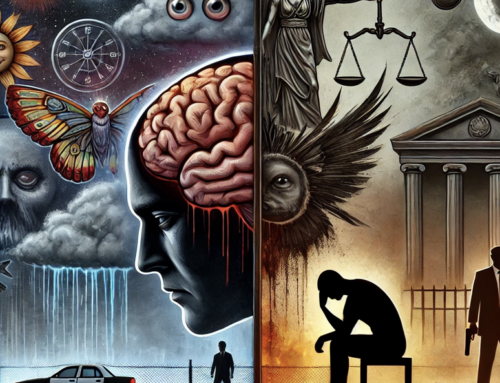One can take many different stances when asked to determine the causes of criminal activity. One area of research that has been gaining popularity views crime as a product of the culture or subculture to which one belongs, rather than strictly blaming it on individual differences. In other words, enculturation plays an important role in the development of criminal behavior; this argument is supported by recent research that will be further discussed, and the disparity in rates of crime between different cultures and subcultures. The purpose of this post is to examine any relevant statistics regarding the differences in violent and nonviolent criminal activity within and between cultures, and to discuss the various theories that have been proposed to explain the reason for imbalance in rates of crime around the world. Variations between the type of crime committed, as well as how it is committed will also be noted as it relates to the topic. Beginning with an analysis of a particular subculture within the United States, which will then lead to cross-national comparisons, the goal of this article is to illustrate how crime is a complicated phenomenon; one theory is not sufficient, rather it takes a multitude of concepts to aid in the determination of the roots of criminal activity.
Heat Hypothesis
Within the United States, the southern region has been notorious for its notably higher rates of violent criminal behavior, specifically lethal violence, when compared with the rest of the country. The heat hypothesis is a theoretical explanation, which proposes uncomfortably warm temperatures are the reason for the elevated violent crime rates in the south. Although there are many studies which have been able to demonstrate an increased propensity for violence in uncomfortably hot conditions in the United States, the same is not true across all cultures, and is unable to explain why violent crime rates within the southern United States are still often higher than other countries exposed to similar temperatures. Although heat may be a factor, claiming human behaviors to be solely due to high temperature may be a bit too simplistic.
Southern Culture of Violence Theory
Another theory that has gained acceptance over the years attributes the violence to a unique subculture of honor that originated with the Scots-Irish migrants in the eighteenth century, when they first arrived in the United States. The southern culture of violence theory suggests today’s increased rates of violent crime in the southern United States is a byproduct of the Celtic cultural values that these migrants brought with them, which has been passed down from generation to generation for hundreds of years. These individuals socially fit into patriarchal systems, which clearly outlined the roles men and women were supposed to follow. Some cultural ideals included a dislike for government and authority, and lex talionis, which demands what others may call an overly exaggerated sense of pride and willingness to defend honor. In time, the Scots-Irish migrants and their descendants slowly began to favor evangelical Protestantism.
Through the process of enculturation, it is believed that these values have evolved and are now enmeshed in our culture today. This is supported by the fact that cities with larger than average Protestant populations tend to have higher rates of violent crime. Additionally, studies have demonstrated an increased aggressive response to insults by individuals who were either raised in the south, or those with parents and grandparents from the south (Doucet et. al, 2013). Furthermore, research has shown a positive association between the number of southern-born white males and females, and the number of homicides. Although still not perfect, the southern culture of violence theory seems to offer a better explanation than the heat hypothesis, as it has been shown that the culture of honor is not only confined to the south but has also been spreading across northern states. It may have originated in the south in the eighteenth century, but has now become intertwined with our culture in the United States as a whole.
Cross-National Comparisons: The IAT
Moving on toward the discussion of cross-national crime comparisons, the institutional-anomie theory (IAT) continues to receive a lot of attention; this theory attempts to explain differences in crime rates through emphasis on the way a particular culture conducts itself economically and institutionally, how the culture expects its citizens to behave, and the degree to which the culture provides opportunities for its citizens to reach those expectations. Originally used to explain nonviolent offenses such as white-collar crimes, it is now suggested to also apply to a variety of violent offenses. It can be argued that the cultural goal in the United States, seemingly more important than all others, is to achieve wealth and become successful monetarily; this is often called the “American Dream”.
According to the IAT, our free market economy is responsible for the high rates of criminal behavior in the U.S. It is suggested that when the economy dominates over other social institutions, and the government does not adequately provide a legal means to achieve the desired wealth, it results in weak normative-controls over how people should conduct their lives. In other words, there is a contradiction between the messages we are given by our government. On one hand there is a strong push to be successful, and on the other we are lacking in legitimate ways to reach success, and only a small fraction of our population will ever be able to reach such a state of economic wealth. Unfortunately, encouraging entrepreneurship and individualistic ideals also leads to social inequality and higher crime. Not surprisingly, a relationship between economic inequality and higher rates of homicide has been found.
According to the IAT, there are four fundamental cultural values responsible for elevated rates of crime: achievement, individualism, monetary fetishism, and universalism. Achievement is determined by how the culture views success and how it judges the value or the status of an individual; in America this is based on our individual accomplishments. A high focus on personal achievement, paired with limited available options to achieve, leads to an anomic lifestyle, in which the ethical boundaries may end up falling into a gray area in favor of personal goals. Individualism refers to the way we are taught to compete with others in order to succeed. In the United States, people must take care of themselves because it is their own individual responsibility; this is in contrast to collectivistic cultures, which tend to take care of the group as a whole. Universalism refers to the universal understanding of these values across all members of the society, regardless of wealth or status. Monetary fetishism refers to the way the society primarily uses money as the measurement of success, rather than by the means in which they actually acquired the money.
The four fundamental cultural values noted above are said to interact with the four basic social institutions: the economy, the family, the educational system, and social policies. When the economy dominates over other social institutions, the influences of the family, educational systems, and social policies are weakened, resulting in a decreased ability to fulfill their cultural roles: to provide support and prevent crime. The four factors act as checks and balances for each other, and when one begins to over power, heightened levels of crime result. According to Hirtenlehner & colleagues:
“Non-economic roles tend to be devalued relative to economic roles; non-economic roles typically are accommodates to economic roles when conflicts emerge; and the logic and mentality of the marketplace penetrates into the non-economic realms of social life. Conversely, a market economy, which is permitted to run largely unchecked by social institutions, reinforces and reproduces a cultural firmament such as the American Dream. It is this constellation of cultural value priorities and institutional power structures that dictates the rate of crime in a society. ”
As quoted above, it is implied that the IAT “anything goes” mentality seeps into all aspects of society. One example of this, and some support for multicultural applicability of the IAT can be seen in China’s cultural shift.
Up until 1979, crime rates in China were considered to be quite low, going as small as 31 per 100,000 citizens in 1964. China began its economic reforms in 1979, and crime rates began to rise significantly; by 1991 it had reached 215 per 100,000 citizens, seven times that of 1964. The government now promotes the idea of allowing people to aim for the goal of becoming wealthier than most others. An economic change within a society, China being an example, is associated with violence and elevated rates of murder. What is interesting about this example is that these observed changes can be seen within the same culture, rather than comparing the crime rates of two different cultures. The people are the same, the location is the same, all that has changed is the planting of the “free market economy” seed. The shift from a classless socialist society to a competitive free market economy comparable to what is seen in America today, has indirectly driven crime rates substantially higher: homicides have increased by 71%, assaults by 171%, robbery by 353%, larceny by 72%, theft by 237%, fraud by 239%, and counterfeiting by 947%. Similar to America, China does not provide adequate legal opportunities to reach this newly promoted goal of monetary success, and so people use what they have available to them, legal or not. What was once a strictly collectivistic culture with socialist ideals, is now adopting an individualistic mindset; taking care of the group is less important than taking care of themselves. Just as suggested earlier, once one of the four basic social institutions begins to dominate, which in this case is the economy, the others begin to have less influence on day-to-day activities, and what was once black and white is now a gray area.
Individualism & Collectivism | America & Japan
The relationship between individualism and collectivism, and its role on criminal behavior has also been researched over the years. Japan is often used as an example of a collectivist culture with low rates of crime. Although not completely considered a free market economy, Japan does employ some of the same principles, and is still able to keep crime rates relatively low. Many researchers have suggested that collectivism is the main reason for the low rates of criminal behavior. In America, individuality is emphasized more so than the group that one may belong to. Self-esteem is based on one’s individual achievements. Generally, if someone didn’t like their job in America, they could go ahead and find another one with no problems other than some inconvenience; generally their self-esteem would not be hurt nor their social life. The same cannot be said for the Japanese culture.
Japanese cultural values contrast sharply with those in America. These differences can be seen in all aspects of life and across all ages, beginning at birth with parental practices, as well as within school curriculum, social relations, and in the workplace . In Japan, uchi is a term used to describe the group one belongs to, along with any rules that must be followed to remain in the group. In most cases, the needs and demands of the group far outweigh the individual’s needs. Soto, refers to the out group, and less attention is spent on these individuals. While becoming more popular in America in recent years, in Japan it is not uncommon to see the passengers of an entire train or bus, with their headphones or earbuds in – no eye contact. In fact, it is estimated that the average teen and young adult in Japan spends 17% of their day with headphones on and listening to music (usually during commute). This just goes to show how uninmportant and insignificant outgroup social relations are viewed in Japanese society. Effort is placed on instilling discipline into their children, as self-control is one of the most highly valued characteristics one can possess in Japan. This is just one of many differences in how children are raised in a collectivistic culture.
Children are taught and expected to depend on their families, much more so than in America. The way punishment is carried out is even very different. For example, individualistic cultures often threaten bad behavior with groundings, being forced to stay in the house. In Japan, the opposite is true; parents threaten to force their children out of the home. In school, critical thinkers are often frowned upon and only rote memorization is seen as being useful. Shared responsibility is taught; when one student does poorly, the others may also be scolded, helping build group cohesion. The workplace brings people a sense of pride, and may even be considered an extended family. Companies offer lifetime employment opportunities, with retirement, benefits, automatic raises, medical care, housing, and recreational activities. Workers know what to expect, and are given a sense of security. Most of their friends are from work, and most if not all of their social activities revolve around the workplace; much of their self-esteem is based on their work environment. The social institutions believed to be lacking in free-market economies, the family, the educational system, and social policies, actually dominate in Japan. Remember, these social institutions are responsible for keeping crime in check. Without the strong desire to “achieve wealth for oneself by any means necessary”, the others keep their influence and are better able to fulfill their roles. This is not to say that Japan and other collectivistic cultures are completely crime-free, just that the group mentality is stronger. One example in which the strong influence of the group may actually be detrimental to crime prevention: when the leader of a group or company themselves commits crimes. In this case, the group members are actually thought to be more likely to stick together and offend themselves.
The goal of this post was to educate the reader on how culture plays a much larger role in the development of criminal behavior than someone may care to acknowledge. The southern culture of violence theory demonstrates the role a cultural belief system can play in society, even across many generations and hundreds of years later. The institutional-anomie theory is often criticized in the fact that it is not valid across cultures, which is why China was used as an example in support of the theory. It is interesting to see how the switch to a free-market economy has brought with it many cultural changes all the way down to the individual level, as well as some significant increases in rates of crime. The reasoning behind variations in crime rates across cultures is still not well understood, other than the fact that there seem to be some well-defined differences in individualistic and collectivistic cultures. Future research should focus on why these cultural differences lead to higher rates of crime.
Fort Lauderdale, Florida’s Leading Criminal Defense Attorney
If you have been charged or believe you may be charged with a crime, an experienced criminal defense attorney is imperative. Kenneth Padowitz, P.A. aggressively handles all State and Federal criminal charges. Contact our law firm to discuss your situation. Our Fort Lauderdale criminal defense attorney will strategically develop a defense designed personally for you and your situation. Kenneth Padowitz, P.A. represents clients throughout Broward County and all of South Florida, including: Fort Lauderdale, Miami, Palm Beach, Boca Raton, Weston, Hollywood, Davie, Hallandale Beach, Plantation, Parkland, Cooper City, and Coral Springs.








